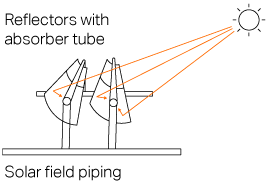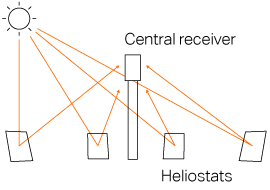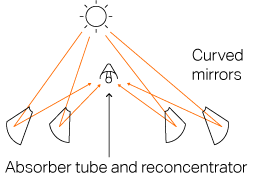
The abundant solar energy available has the potential to provide the whole world with energy. Decarbonization and electrification are strong drivers for development and the solar power sector is currently growing exponentially.
Solar power plants harness energy either in photovoltaic (PV) cells or thermally in concentrated solar power (CSP) systems. There are four main CSP technologies; parabolic trough, solar tower, linear fresnel, and parabolic dish.
Parabolic trough

The parabolic trough is currently the most common CSP technology. It consists of a group of reflectors that are curved in one dimension in a parabolic shape to focus sun rays onto an absorber tube that runs at the center of the trough. The absorber or receiver tubes are subjected to high temperatures and corrosive heat transfer fluids (synthetic oil or molten salt) which is why austenitic stainless steel grades are typically used.
Solar Tower

The solar tower uses heliostats to reflect and concentrate the sunrays onto a central receiver placed at the top of a fixed tower. In the central receiver, heat is absorbed by a heat transfer fluid, which then transfers the heat to a heat exchanger to produce steam that powers a steam turbine. Due to the combination of very high temperatures and corrosive molten salt heat transfer fluids, nickel alloys are a suitable choice.
Linear Fresnel

The linear Fresnel reflector uses rows of flat or slightly curved mirrors to reflect the sun's rays onto a downward-facing linear receiver. It is a somewhat more simple version of the parabolic trough and subsequently a cheaper technology. An additional advantage is higher land-use efficiency than other CSP technologies. The choice of receiver tube material depends on the operating temperature and heat transfer fluids.
Parabolic dish
The parabolic dish collector concentrates light in a single focal point, which allows this type to achieve the highest concentration ratio and solar-to-electric efficiency of all other types of CSP technologies. Typically, a Sterling engine that converts the concentrated solar energy into electricity is placed at the focal point.
Trends
To take advantage of economies of scale, CSP projects are becoming larger with solar towers and parabolic troughs the dominating technologies. Most future CSP plants also include thermal storage capacity. This enables dispatchable electricity generation that matches demand rather than available sunlight. Most of the towers, which operate at a higher temperature than troughs, use molten salts for thermal storage.
Material challenges
The use of molten salt at high temperatures leads to highly corrosive conditions, thus a need for advanced corrosion-resistant alloys.
We offer a wide range of stainless steel and nickel alloys suitable for very many applications and conditions.